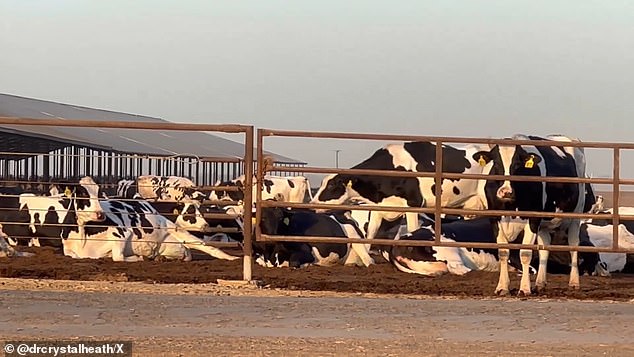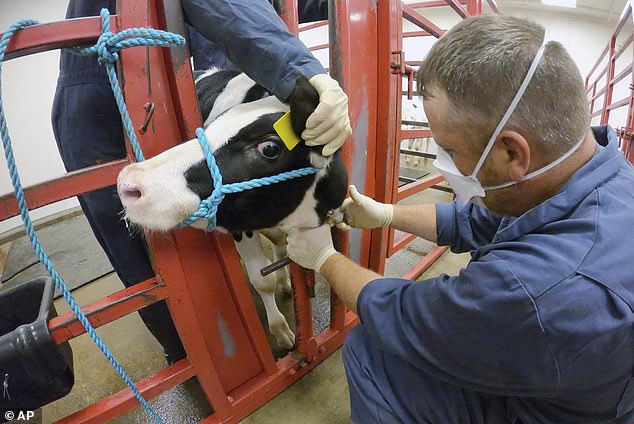Sinister truth behind images of dead cows piling up in California
A dystopian scene emerges in California as dairy farmers battle a brutal disease.
Dead cows and calves piled up on the side of the road, rotting in the heat, surrounded by crows, vultures and thick swarms of black flies.
After wiping out tens of millions of birds worldwide, H5N1 bird flu is sweeping through U.S. dairy farms.
A total of 124 herds have been affected in California alone, in addition to nearly 200 herds across 13 other states, including Colorado, Idaho and Michigan.
Some fallen cattle are deliberately left on the side of the road to reduce the chance of the virus spreading on farms.
There are increasing concerns that this could have a knock-on effect on milk production and prices.
Eggs have already been hit by shortages and price increases following the arrival of bird flu in chickens.
Dead cows are piling up in California as dairy farmers battle the H5N1 bird flu, which made landfall in the state in August
Jimmy Andreoli II, spokesman for Southern California rendering company Baker Commodities, told the LA times: ‘There has definitely been an increase in animal falls lately, and some of that has to be attributed to the long, hot summer we’ve had.
“And some of it, you know, is certainly attributed to the H5N1 virus,”
One of his drivers collected 20 to 30 animals from one farm in a single day, he added.
Infected carcasses are taken to a rendering site – a facility where animal remains are processed – to be turned into “high-protein” animal feed and fertilizers, or liquids used in fuels, paints, varnishes, lubricants and other industrial products.
Removing and processing these carcasses eliminates the risk of them transmitting bird flu to other animals or people.
California is the nation’s largest dairy producer, and the state currently holds the record for the most bird flu-infected livestock herds in a single state, in addition to a large number of cases among dairy workers.
Even cows survive the virus, it takes its toll on their milk production.
Observations suggest that production will drop to only 60 or 70 percent due to the virus, the LA Times reported.
It is possible that infected dairy cows could regain full milk production when they enter a new lactation cycle, but that remains to be seen.
The effect this will have on dairy prices remains unclear, but if experts’ predictions are correct, the dairy industry could become increasingly destabilized as cases and deaths in livestock increase.

A video shows a California cattle ranch appearing to keep sick cows next to healthy cows, many of which are ‘lying down, and some flat’
In a video on
“The sick cows must be separated from the healthy ones,” she wrote.
“I’m not sure what’s going on here, but a lot of cows were on the ground, and some were flat. The destruction truck did come to this facility in the morning, but no dead pile was visible from the road.”
John Korslund, a retired U.S. Department of Agriculture veterinary epidemiologist, told the LA Times that cattle carcasses likely pose little risk to public health as recent high temperatures and decomposition of the animals neutralize the virus.
But it is possible for people to contract bird flu from infected carcasses, according to the Center for Disease Control (CDC).
In California alone, there have been six confirmed human cases of bird flu among dairy workers, and five more are suspected in the Central Valley as more and more cattle succumb to the disease.
A total of 27 human cases have been reported nationwide this year, many of which resulted from exposure to infected poultry or livestock.
Before 2024, only one American had been infected with bird flu. The first reported human case in the US occurred in April 2022 in Colorado, after a person was exposed to infected poultry.
Heath officials have now begun investigating the first cases of human bird flu in Washington state after four poultry workers tested positive for the virus.
This makes Washington the sixth state to record human infections of the H5N1 bird flu.
Experts fear the virus will mutate as it jumps between humans and animals, acquiring mutations that could allow it to spread from person to person and eventually cause an epidemic.

The bird flu outbreak is growing in the US and is spreading rapidly among dairy herds in several states
To date, there has been only one case of bird flu in a patient who has had no known contact with animals.
The patient was infected and hospitalized in Missouri, and seven people who came into contact later reported symptoms.
Still, officials say this so-called “cluster” does not provide evidence that the virus spreads easily among people.
But the impact of the virus on the agricultural sector is great.
Infections on poultry farms have led to egg shortages, driving prices up to $5 per dozen.
They have fallen since then but now appear to be rising again, said Brian Earnest, an animal protein economist at CoBank.
At one point, the shortage caused the price of a dozen plain eggs to rise to almost $5. Prices have fallen somewhat, but are going back up.
Additionally, former government food tester Dr. Darin Detwiler told DailyMail.com that people can contract the virus from eating infected eggs.
He said raw eggs pose the greatest risk Popular breakfast foods such as soft-boiled eggs, poached eggs or dishes such as eggs benedict should all be avoided.
This is because the eggs “may not reach a temperature high enough to kill any viruses.”
“Instead, stick to thoroughly cooked options, such as hard-boiled eggs, scrambled eggs, and fully cooked omelettes,” he adds.
State and federal officials have said it is safe to drink milk from California and other states with confirmed cases of bird flu in livestock herds if it has been pasteurized because this process kills the virus.
